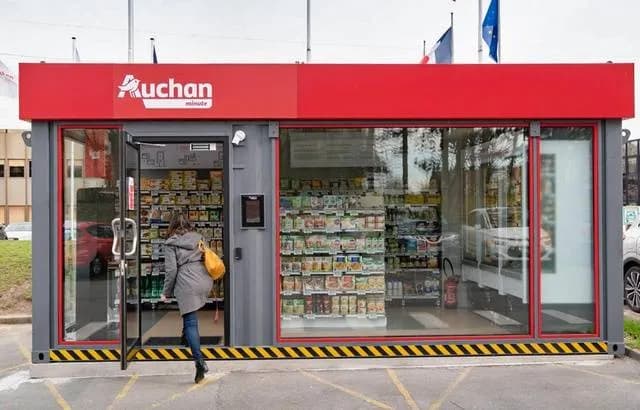GRAND DISTRIBUTION: The Auchan group has unveiled its first mini-supermarket prototype allowing customers to do their shopping completely independently without even having to go to the checkout
- After the Auchan Minute containers, the retail giant presented Auchan Go, a new smart store concept.
- The technology deployed allows customers to do their shopping naturally without having to go to the checkout.
- This innovation, in the test phase at the Auchan headquarters, will be industrialized with a view to its deployment in France.
“In three months, we installed this store in place of a meeting room,” says Emilie Soleri, deputy general manager of Auchan Retail in charge of e-commerce. In this “intelligent” mini-supermarket, there is no cashier or even cashier, no staff, only customers. Called Auchan Go le lab, this new concept is the upgraded version of the “Auchan minute” containers, a kind of giant vending machine, successfully tested on the campus of Edhec, an engineering school based in Croix. So, do Auchan employees have anything to worry about?
This is the question we were already asking ourselves when at the time, in 2019, Auchan Retail had installed the first Auchan Minute in the car park of its headquarters, in Villeneuve d’Ascq. Two years later, a second container, in beta version of Auchan Go, was placed on the Edhec campus. “It was a very rapid success with the students who found it both in terms of price and in terms of availability”, assures Basile Guérin, in charge of innovation at Auchan retail. But unlike China, a country from which Auchan withdrew a few years ago, “there is no development strategy in France for Auchan Minute”, he adds.
“We are not going to make hypermarkets on this model”
For Auchan Go, it’s not the same song. The prototype which was presented to the press on Wednesday offers a thousand references on 86 m2. It will be used to wipe the plaster and collect as much customer feedback as possible in order to improve it. “We have set ourselves a year of testing before considering deployment,” acknowledges the Deputy CEO. “The goal is to make this concept industrialize so that each new store opening costs us less than the previous one,” adds Samir Amellal, director of information systems (DSI) for the group. According to Basile Guérin, the technology implemented for this prototype is mature enough to envisage commercial areas of 1,000 m2: “We are not going to make hypermarkets on this model, on the other hand,
Auchan Retail’s idea is to initially target closed spaces, such as businesses or university campuses. “With telework, there are a lot of meeting rooms that are no longer used. You have to consider this as a service rendered to employees,” explains Auchan’s Mr Innovation. To qualify all the same, because there is no question of canvassing SMEs. “Here at headquarters, we have 2,500 employees. I think this is the volume of potential customers below which it is not profitable to go,” says Emilie Soleri. For an installation in an open environment, the concept will have to be adapted and there is no question of leaving the place without any staff: “We can’t imagine putting a security guard, but perhaps an employee who will provide advice, ensure a parcel drop-off and pick-up service,
In short, there are still many uncertainties about the deployment of Auchan Go, even if it is one of the priorities of the “digital transformation of the company” plan put in place by the new management. On the other hand, the technology is ready, we were able to put it to the test. You enter the store using an app or simply with your credit card. Countless cameras scan our morphology and vectorize our movements, on the lookout for what we take in the gondolas equipped with scales. Nothing escapes the system, which obviously detects if you put an item back after taking it. We go out freely, without scanning the items, which will be automatically debited from your credit card. A few minutes later, we receive the receipt by email. “The reliability rate exceeds 99%,” assures Basile Guérin. It’s amazing, it must be recognized, but innovation has a price, “between 10 and 30% more expensive depending on the items”, assumes Emilie Soleri. The “price of the service”, because transporting the products in “hyper proximity” also has a cost, justifies the Deputy DG.




